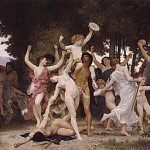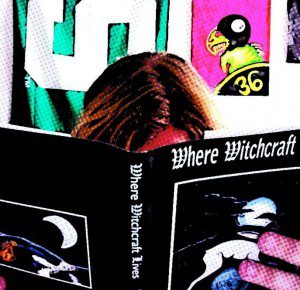 I hate to generalize, but Pagans are readers. We read a lot of different stuff too. Some of us read a lot of Fantasy and Science Fiction (is anyone else anxiously awaiting Fool’s Assassin by Robin Hobb this August?) and some of us drift more towards non-fiction. I read a little bit of both but primarily non-fiction. A lot of that reading is for research purposes and ends up finding its way into Raise the Horns, but other times it’s “just for fun,” or as fun as Pagan history books can be. When I’ve read enough stuff (and I’m able to look up from this year’s World Cup) it’s time for some book reviews.
I hate to generalize, but Pagans are readers. We read a lot of different stuff too. Some of us read a lot of Fantasy and Science Fiction (is anyone else anxiously awaiting Fool’s Assassin by Robin Hobb this August?) and some of us drift more towards non-fiction. I read a little bit of both but primarily non-fiction. A lot of that reading is for research purposes and ends up finding its way into Raise the Horns, but other times it’s “just for fun,” or as fun as Pagan history books can be. When I’ve read enough stuff (and I’m able to look up from this year’s World Cup) it’s time for some book reviews.
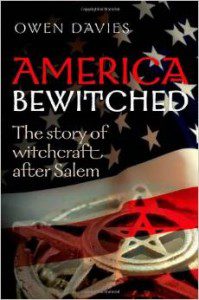 American Bewitched: Witchcraft After Salem by Owen Davies (Oxford University Press, 2013). Very quietly Owen Davies has turned into “the other go-to scholar” (after Ronald Hutton) when it comes to the history of Western Occultism. Some of his previous books are among my favorite in the genre (especially Grimoires: A History of Magic Books) and while America Bewitched isn’t a bad book by any means, I’m not sure that it’s quite as good as Davies earlier work. It’s also relatively short, just 222 pages before the footnotes.
American Bewitched: Witchcraft After Salem by Owen Davies (Oxford University Press, 2013). Very quietly Owen Davies has turned into “the other go-to scholar” (after Ronald Hutton) when it comes to the history of Western Occultism. Some of his previous books are among my favorite in the genre (especially Grimoires: A History of Magic Books) and while America Bewitched isn’t a bad book by any means, I’m not sure that it’s quite as good as Davies earlier work. It’s also relatively short, just 222 pages before the footnotes.
America Bewitched isn’t a book about Modern Witchcraft as Contemporary Pagans understand it, instead it’s more a history of the word “witch” in the United States. Not surprisingly the book confirms what I’ve generally believed the last ten years, that the word witch up until relatively recently usually meant “bad magic user.” People just did not generally label themselves witches until relatively recently. Witches were users of negative magic or figures from literature and fairy tales, and there wasn’t much in between. Disturbingly people were still being killed for “witchcraft” in the early decades of the Twentieth Century. We tend to tune out “witch killings” post-Salem, but stupidity (then as now in certain parts of the United States) was prevalent even 250 years after Salem. America Bewitched is a chilling look at America’s past, and a solid look at “witches” in American history.
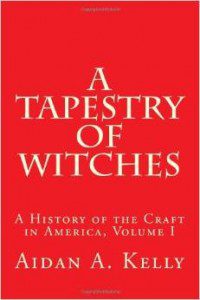 A Tapestry of Witches: A History of The Craft in America, Volume One by Aidan Kelly (Hierophant Wordsmith Press, 2014). I was nearly sent a free PDF of this book, but I hate PDF’s so I scrounged together some cash and contributed to the Kelly Kids college fund. Tapestry contains (what felt like) some material previously published at Kelly’s Including Paganism blog, but it mostly fits nicely into the book. I say mostly because Tapestry really does read like a collection of blog posts linked together to form a larger narrative. A lot of that is because Kelly doesn’t “historian” the material, he simply presents what he has experienced and what people have sent him about early American Witchcraft over the years.
A Tapestry of Witches: A History of The Craft in America, Volume One by Aidan Kelly (Hierophant Wordsmith Press, 2014). I was nearly sent a free PDF of this book, but I hate PDF’s so I scrounged together some cash and contributed to the Kelly Kids college fund. Tapestry contains (what felt like) some material previously published at Kelly’s Including Paganism blog, but it mostly fits nicely into the book. I say mostly because Tapestry really does read like a collection of blog posts linked together to form a larger narrative. A lot of that is because Kelly doesn’t “historian” the material, he simply presents what he has experienced and what people have sent him about early American Witchcraft over the years.
Sometimes when I read a book I get a very clear picture of the audience the author is writing for, but with Tapestry I was often unsure. Is this an oral history of American Witchcraft? Is this an academic look at Witchcraft? There are moments in the book where Kelly dons his historian hat and other times when he simply seems to accept whatever claim is being made. I don’t have a problem with either approach (but would probably prefer the first one) I just wish Kelly had been more consistent. Despite my quibbles this is a fascinating book, and illustrates just how closely connected the various strands of American Witchcraft were back in the 60’s and 70’s. Today we seem to bicker about everything little thing, back then there seemed to be a real effort to find commonalities and set aside the desire to be “witchier than thou.”
Despite how some feel about Kelly I think Tapestry is a valuable book. Hearing many of these stories straight from the people who lived through them was a fascinating window into a very different time in our history, and having all these recountings all in one place is invaluable to anyone interested in the emergence of Modern American Pagan Witchcraft. This is essentially a self-published book, and there are a few small errors sprinkled through the text, but the problems are minor.
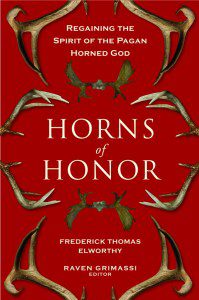 Horns of Honor by Frederik Thomas Elworthy and edited with additional commentary by Raven Grimassi (Samuel Weiser, 2013). Horns of Honor was originally published in 1900 and very much reads like it. I found most of Elworthy’s original prose on the tedious side, but there’s information here that can be worked with. In my younger, snottier days I tended to simply dismiss most works and authors rejected by mainstream scholars. Today I’m more likely to simply look at anything as a source of inspiration. Even if some of Elworthy’s conclusions are incorrect that doesn’t mean that the bits of religion and folklore he wrote about don’t have value. There’s a lot of stuff here than can be used as the basis of a ritual or spell. It’s also interesting to read the books that most likely inspired the first and second generation of Modern Witches.
Horns of Honor by Frederik Thomas Elworthy and edited with additional commentary by Raven Grimassi (Samuel Weiser, 2013). Horns of Honor was originally published in 1900 and very much reads like it. I found most of Elworthy’s original prose on the tedious side, but there’s information here that can be worked with. In my younger, snottier days I tended to simply dismiss most works and authors rejected by mainstream scholars. Today I’m more likely to simply look at anything as a source of inspiration. Even if some of Elworthy’s conclusions are incorrect that doesn’t mean that the bits of religion and folklore he wrote about don’t have value. There’s a lot of stuff here than can be used as the basis of a ritual or spell. It’s also interesting to read the books that most likely inspired the first and second generation of Modern Witches.
Despite the cover art this is a book very much about horns and not antlers. (That’s a problem a certain blog seems to have as well, he said while looking at his logo.) Anyone looking for insights into Herne and his peers will be disappointed. If there’s a central premise to Elworthy’s original work it’s that horns on the heads of gods and heroes later became the crowns of royalty. Elworthy is also no pagan apologist, his text is full of Christian gloating (we won!). Grimassi’s introduction adds some insight into the creation of the original text and added to the book, though I take exception to the idea that Cernunnos was “associated with fertility” in ancient art. Those interested in ancient folklore and Pan and/or Dionysus will find things to enjoy in this book.
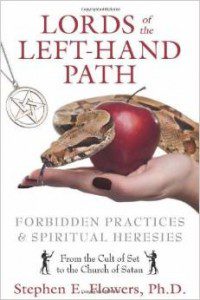 Lords of the Left-Hand Path: Forbidden Practices & Spiritual Heresies from the Cult of Set to the Church of Satan by Stephen E. Flowers (Inner Traditions, 1997, revised edition 2012). Whether we want to admit it or not, Modern Paganism is in some ways tied to Modern Satanism. Both emerged in the latter half of the Twentieth Century, both can be seen as opponents of Christianity, both sometimes share a magical world view, and both share a few personalities which have been largely influential in their respective developments*. (Aleister Crowley was neither a Pagan or a Satanist, but his writings have certainly influenced both.) I’ll never be a fan of the Left-Hand Path, but to truly understand our history I feel as if I need to understand the other religious and spiritual histories that are often misidentified as my own. For a long time now I’ve been waiting for a thorough academic history of Modern Satanism, and Flowers book comes pretty close to filling that niche.
Lords of the Left-Hand Path: Forbidden Practices & Spiritual Heresies from the Cult of Set to the Church of Satan by Stephen E. Flowers (Inner Traditions, 1997, revised edition 2012). Whether we want to admit it or not, Modern Paganism is in some ways tied to Modern Satanism. Both emerged in the latter half of the Twentieth Century, both can be seen as opponents of Christianity, both sometimes share a magical world view, and both share a few personalities which have been largely influential in their respective developments*. (Aleister Crowley was neither a Pagan or a Satanist, but his writings have certainly influenced both.) I’ll never be a fan of the Left-Hand Path, but to truly understand our history I feel as if I need to understand the other religious and spiritual histories that are often misidentified as my own. For a long time now I’ve been waiting for a thorough academic history of Modern Satanism, and Flowers book comes pretty close to filling that niche.
The book is a little slow to start but once it enters the Renaissance Era it becomes very readable and surprisingly thorough. Flowers’ chapters on Anton LaVey and Michael Aquino were perhaps my favorite. I’ve never agreed with either of those two men but as thinkers and innovators (for good or for ill) they deserve to have their histories shared in an intelligent and thorough fashion, and Flowers provides it in Lords. Flowers isn’t quite just the interested historian, he’s actually a member of The Temple of Set, but this isn’t necessarily a scholarly book and the author’s sympathies didn’t particularly hinder my reading of the book. Perhaps it was just my imagination but I felt as if Flowers was a bit sympathetic towards Hitler and the Third Reich in the chapter An Interlude in the Absolute Elsewhere: Adolph Hitler and the Modern Mythologizing of Evil. I also would have liked to see a chapter on modern Theistic Satanism, an oversight that keeps the book from being truly complete.
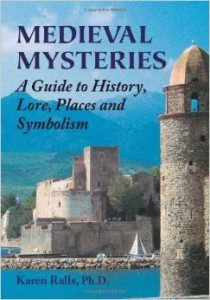 Medieval Mysteries: A Guide to History, Lore, Places, and Symbolism by Karen Ralls (Ibis Press, 2014). The author of Medieval Mysteries, Karen Ralls, has a Ph.D., but she misplaced it somewhere during the writing of this book. I was hoping that this would be a scholarly history of groups like The Knights Templar and the Cathars along with places such as Rosslyn Chapel, but it was far from that. This is a popular, and often speculative, history and it left me feeling rather disappointed. A lot of the information in Mysteries felt dated, like I was reading instead of watching an episode of In Search Of . . . . back in the 1970’s.
Medieval Mysteries: A Guide to History, Lore, Places, and Symbolism by Karen Ralls (Ibis Press, 2014). The author of Medieval Mysteries, Karen Ralls, has a Ph.D., but she misplaced it somewhere during the writing of this book. I was hoping that this would be a scholarly history of groups like The Knights Templar and the Cathars along with places such as Rosslyn Chapel, but it was far from that. This is a popular, and often speculative, history and it left me feeling rather disappointed. A lot of the information in Mysteries felt dated, like I was reading instead of watching an episode of In Search Of . . . . back in the 1970’s.
While I wasn’t all that thrilled with some of the histories in Ralls’ book, the book itself is an impressive package. It’s full of full color photographs and fascinating sidebars to the main text. While I wouldn’t recommend Mysteries as history, I might recommend it as a travel guide. As someone preparing for a pilgrimage to Great Britain there were a few parts of the book that will probably prove useful to me in the future. For those interested in a more fanciful interpretation of European History there’s a lot to like in this book, I just have trouble taking anything seriously that has a section called Merlin and the Goddess. As I sometimes note in these occasional reviews this book was probably not written for me, and I can see it appealing to fans of Caitlin Matthews and R.J. Stewart.
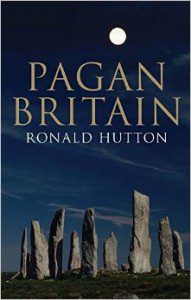 Pagan Britain by Ronald Hutton (Yale University Press, 2014). Now this is the kind of book written for me! It’s completely academic without being inaccessible, and nearly every moment of it is fascinating. Hutton surveys the various disciplines of archeology, anthropology, and history and comes up with a unique and comprehensive look at ancient paganisms past in Great Britain. Writing about archeological digs and the findings therein can often prove difficult, but Hutton accomplishes it all with ease, and in doing so brings very ancient history to life in 2014. One of the great difficulties with early paganisms is how much we just don’t know, and how that has resulted in various theories over the decades. Hutton presents all of it, honestly writing about the gaps and even giving space to the theories that he’s less inclined to take seriously.
Pagan Britain by Ronald Hutton (Yale University Press, 2014). Now this is the kind of book written for me! It’s completely academic without being inaccessible, and nearly every moment of it is fascinating. Hutton surveys the various disciplines of archeology, anthropology, and history and comes up with a unique and comprehensive look at ancient paganisms past in Great Britain. Writing about archeological digs and the findings therein can often prove difficult, but Hutton accomplishes it all with ease, and in doing so brings very ancient history to life in 2014. One of the great difficulties with early paganisms is how much we just don’t know, and how that has resulted in various theories over the decades. Hutton presents all of it, honestly writing about the gaps and even giving space to the theories that he’s less inclined to take seriously.
In some ways Pagan Britain is a reworking of Hutton’s earlier Pagan Religions of the Ancient British Isles so some of the material felt a bit familiar, but it was all completely updated, and often with different results. Often these days when many of us think about “ancient British paganism” we think about Druids and the Celts, but one of my favorite parts of PB is the focus on paganisms outside of that area. The Saxons are integral to the story, and were often the “re-introducers” of paganism in specific areas. When writing about the alleged triumph of Christianity over British paganisms Hutton presents what actually resulted and was practiced for centuries as a merging of traditions. The names did change, but much of the song essentially remained the same, and very much what we call pagan. This is another strong addition to Hutton’s catalog of works, and I for one am happy that one of the world’s best and most readable British historians continues to write things of great interest to my extended Pagan community.
*Indeed here, particularly with this book. Flowers uses the pen name Edred Thorsson when writing about the runes or Germanic NeoPaganism.



